
The Western Foundation of Vertebrate Zoology Bird Museum and Research Center is a 501(c)(3) non-profit charitable corporation. It is both a natural history collection specializing in eggs and nests of birds from around the world and a research and education institution dedicated to researching and teaching about bird conservation. The WFVZ Bird Museum’s collections are among the largest in the world, and its mission is:
With more than 20,000 nests, 58,000 bird study skins, and over a million individual eggs, the collections and their data are invaluable to researchers and educators. The WFVZ Bird Museum contributes to bird conservation through bird education programs for scientific professionals and the public, and field- and collections-based research projects and publications. The WFVZ Bird Museum has contributed information to thousands of research projects since our inception in 1956. Researchers may visit the museum to use our specimens or specimens may be loaned out. Our specimens are also digitized on our online database and are available to anyone! If you are interested in learning more about using our specimens for research, please see our Specimen Loan Information page or visit our online collections database – which we are continually adding to!
At the WFVZ Bird Museum, we also conduct our own research studies. Beginning in the 1960s, we conducted inventories of eggs, nests, and birds in the tropics in places such as Chile, Costa Rica, Ecuador, Malaysia, Mexico, and Samoa. We have also conducted numerous studies in Guatemala focused on breeding birds and their egg and nest characteristics, as well as the restoration of the Rio Motagua and its impact on bird species. Today, our primary study areas are the Santa Clara River, the northern Channel Islands and Channel Islands National Park, and the Santa Monica Mountains National Recreation Area and surrounding open spaces. Our focus is monitoring bird population trends and how birds are responding to restoration efforts, specifically along the Santa Clara River, and studying three endangered bird species that rely on this riparian habitat for survival; Least Bells’ Vireo (Vireo bellii pusillus), Southwestern Willow Flycatcher (Empidonax traillii extimus), and Western Yellow-billed Cuckoo (Coccyzus americanus occidentalis). For additional information about our previous and current research projects, please see our Research page.
The WFVZ Bird Museum is also an important resource for students and the public. Artists often visit our museum as they benefit from seeing our live mounts up close. We also frequently receive educational groups and offer specific activities and tours for school and other educational groups to expand their knowledge about birds and their conservation. Our materials play key roles in understanding diverse topics such as avian systematics and evolution; the effects of environmental contamination; and changes in bird numbers, distributions, and habitat use. If you are an educator and are interested in bringing your class, please see our For Teachers page.
We also offer introductory and professional classes for those focused on honing their bird identification skills. We offer wintering birds identification, breeding birds, egg and nest identification, and vocalization classes. Classes are held both in the museum and out in the field at our study sites. If you are interested in taking one of our classes, please see our Classes and Training page.
If you are interested in visiting the museum and seeing our immense collection, please see our Museum Visits page to book an appointment. We look forward to seeing you!
Interested in becoming a member? Visit our Membership page today to see how you can support the WFVZ Bird Museum!

Read more about the history of the WFVZ Bird Museum and Research Center here.
